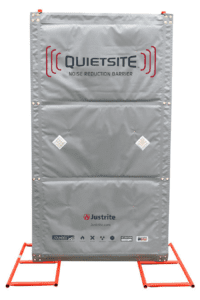Construction sites are known for being loud, but excessive noise is not something workers and neighbors just have to deal with. As with any health and safety issue, construction site noise control is everyone’s responsibility. The Occupational Safety and Health Administration (OSHA) reminds construction professionals that construction noise is a preventable cause of permanent hearing loss. Exposure to loud construction noises poses other concerns, such as making it difficult to communicate safety messages with co-workers or hear approaching vehicles. Fortunately, there are several construction site noise control measures and devices you can implement to protect workers and the public from harm.
Protection for Workers
Worker protection from the perils of construction site noise comes in two forms: mitigation and personal protective equipment (PPE). Taking steps to tone down the noise before it reaches workers’ ears is the best option. Prior planning of work assignments and worksite layout is the first step. Scheduling the loudest activities during times when fewer workers are on the site is one effective strategy.
Operators of circular saws, belt sanders, and nail guns, and other loud equipment, of course, cannot put distance between themselves and their hand tools. But they may be able to isolate themselves from others. Extension cords give workers a wider range of workspaces. Similarly, generators (use the smallest, quietest available that will still get the job done), pumps, and other stationary equipment can be shielded with noise reduction barriers.
Personal protection consists of shielding ears so loud noises cannot penetrate. Earplugs and earmuffs come in several varieties designed for different duties and durations.
Earplugs fit inside the ear. They conform to each person’s unique ear canal shape, forming a snug seal against construction site racket. Comfort is key, as ill-fitting earplugs may tempt wearers to remove them, defeating their purpose. Workers should find a type and size that they can insert and wear for long stretches:
- Roll-downs – Worn once and then discarded, these foam plugs are rolled between the thumb and forefinger, slightly compressing them before they are inserted. Once in the ears, they expand, filling the opening.
- Plastic – Reusable for 10 to 20 days, plastic earplugs reduce waste and cost. Different sizes and shapes allow workers to find a style that offers the best fit, protection, and comfort. Pliable and smooth, they need not be rolled or manipulated before inserting them.
- Push-In Foam – Designed to combine the softness of foam and the fit and hygienic and environmental benefits of reusable varieties, push-in-foam styles are used for a week on the jobsite before being discarded for a new pair. Their dense foam construction offers better construction site noise control.
Earmuffs fit over the fleshy parts of the ears, using sound-attenuating materials and a snug seal to keep loud noises at bay. Construction workers often prefer earmuffs in difficult environments, as inserting plugs into the ear can transfer dirt and grime to sensitive ear canals. They may not be as effective as earplugs in high-noise areas, however, as the seal around the ears can slip. They can be bulky and heavy, though they can work with hardhats, respirators, and other PPE. Passive earmuffs use foam or other noise-absorbing material to protect the ears. Electronic earmuffs use circuitry to counter the effects of noise. Some can detect decibel levels and block noises above a certain level while allowing “normal” sounds – conversations, warning signals, traffic noise, etc. – to pass through.
Protection for the Public

Blocking noise before it reaches people’s ears protects both workers and passers-by. Construction companies, like all businesses, are required to control noise. Non-compliance can result in hefty fines and potentially costly construction delays. Prefabricated panels like Justrite Quiet Site Noise Reduction Barriers absorb and deflect sound at the source, before it can cause damage. The 4-foot by 6-foot and 4×8 modular panels can be connected and configured in a variety of shapes to surround machinery or create a barrier wall between noisemakers and workers and the public. Foldable, stackable, and easily assembled, Justrite’s fire- and water-resistant barriers can be mounted on link fence, scaffolding, or steel frames.
Prolonged exposure to loud construction noises can cause permanent, irreparable hearing loss. Even noises that require workers a few feet apart to raise their voices to be heard are loud enough to cause damage. Contractors need to protect their workers, site visitors, and neighbors from the effects of noise pollution. Erect barriers to contain noise-generating equipment and provide workers with a variety of earplugs and earmuffs to ensure they can find a size and type that is comfortable and effective.
The Pro Group’s technical and sales team members are experts in local noise compliance regulations. Contact us for advice on the products and applications you need to implement a noise-reduction protocol to stay in compliance and protect the people at and around your construction site.



